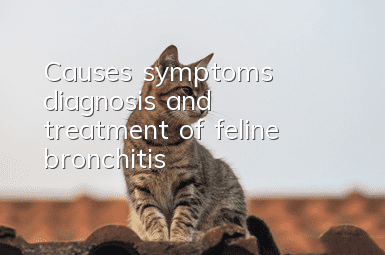Causes, symptoms, diagnosis and treatment of feline bronchitis

Before understanding feline bronchitis, let’s talk about the role of the bronchi through a simple anatomy of the cat’s respiratory process. During breathing, oxygen enters the trachea through the back of the throat, splits into two airways, called bronchi, and then passes through the two bronchi to the two lobes of the lungs to achieve the purpose of breathing. .
Regarding bronchitis, in layman’s terms, it is an inflammatory disease in the lower airways of cats that causes daily coughing. Because it is a relatively common disease in life, today I will give you some knowledge about this disease so as not to panic when something happens.
The following part of this article consists of eight parts, namely: the cause of feline bronchitis, types of feline bronchitis, symptoms of feline bronchitis, diagnosis of feline bronchitis, treatment of feline bronchitis, preventive measures of feline bronchitis and Home care, which cats are more susceptible to bronchitis, the differences and connections between feline bronchitis and "feline asthma." The article is too long, but it is relatively complete. For the convenience of reading, the key contents are bolded. If you are interested, please read the full text in detail.
Causes of feline bronchitis
Feline bronchitis can be caused by a variety of reasons, the two most common ones being respiratory tract infection and allergens.
Respiratory tract infection.
Allergens: tobacco, household dust, cat litter dust, food allergies, sprays, perfume, pollen, etc.
Types of feline bronchitis
Chronic bronchial disease in cats is usually manifested by these two diseases, namely chronic bronchitis and feline asthma. Feline asthma and feline chronic bronchitis are two different diseases. There are some differences in causes and clinical symptoms, but there are also many similarities. This article is explained in detail in the subtitle "The Difference and Connection between Feline Bronchitis and Feline Asthma" at the end of the article.
Bronchitis is divided into two types: acute bronchitis and chronic bronchitis.
Acute bronchitis: The cause is usually viral infection, which will cause acute and persistent retching and coughing, accompanied by pain, the production of green or yellow sputum, and some cats will also have symptoms of fever. Acute bronchitis is relatively rare.
Chronic bronchitis: Symptoms are similar to acute bronchitis (cough), but last longer and become less frequent. Sometimes a cough breaks out without any warning, and some cats also experience shortness of breath while resting. Chronic bronchitis may also develop from multiple episodes of acute bronchitis, which is a progressive disease.
Symptoms of feline bronchitis (common)
Symptoms of feline bronchitis include one or more of these ten:
Cough (signSymptoms), intermittent retching or vomiting, fever, poor appetite, poor energy, lethargy, phlegm (yellow or green, which is mucus in the lungs, bronchi and trachea), sneezing, shortness of breath while resting or sleeping, reaching the disease Intermittent dyspnea (after exercise) may occur in the medium term.
Diagnosis of feline bronchitis
The following examinations can be done at the pet hospital to diagnose bronchitis:
Understand the medical history, blood routine, chest X-ray, examination of the trachea and bronchi, secretion-sputum specimen culture and drug sensitivity test, bronchoscopy, etc.
Just leave the specific operation, diagnosis methods and parameters to the veterinarian.
Treatment of feline bronchitis
The treatment plan is determined by the cat’s bronchial condition, cause, secondary diseases and clinical status. Common treatment methods are as follows:
Oxygen infusion, non-oral corticosteroid therapy, nebulized + inhaled bronchodilator drugs, systemic bronchiectasis drug treatment, etc.
Drug treatment: cough suppressants, bronchodilators, anti-inflammatory, antibacterial treatment, etc.
The best treatment options vary from cat to cat and should be tailored to the situation.
Preventive measures and home care for feline bronchitis
We cannot completely prevent the occurrence of bronchitis, but can only reduce the incidence through some measures.
Record the maximum healthy activity duration of the cat (from calmness to rapid breathing, some cats will also make a "dog breath" action), and limit the duration to avoid shortness of breath (rapid breathing) often caused by excessive exercise.
Control the cat’s weight and avoid being overly obese. Cats may be cuter if they are fatter, but they are not necessarily healthy.
Maintain a good environment with less dust, dust, chemical fumes and tobacco, and do not smoke when sharing a room with cats.
Home care: You can create a steam environment for cats, such as a shower room or a small humidifier, etc., in order to soften the infected mucus in the bronchus.
Which cats are more likely to suffer from bronchitis
Bronchitis can occur in any cat, but cats with these two conditions have a higher chance of getting the disease:
Cats that are obese and live in a poor living environment (dusty, allergens, tobacco environment, etc.).
The difference and connection between feline bronchitis and "cat asthma"
The connection between the two: Feline asthma is an advanced disease of feline bronchitis. The most significant clinical symptom of feline bronchitis and mild asthma is cough. Both are used in disease judgment and prognosisThere are great similarities in treatment and treatment, but there are still differences.
The difference between the two: chronic bronchitis is secondary to airway damage, while feline asthma is an allergic inflammatory disease of the lower respiratory tract. Although they are all diseases of bronchial changes, there are still certain differences. Feline chronic bronchitis affects airflow due to cellular infiltration and bronchial remodeling, but does not cause spontaneous bronchial stenosis. Severe feline asthma may cause bronchoconstriction and stenosis, persistent coughing, and life-threatening acute bronchoconstriction (bornchoconstriction).
This ends the knowledge point of this article. If you have suffered from chronic bronchitis, you must treat it in time. The pressure brought by inflammatory diseases to the respiratory system may also cause the bronchial wall to thicken, making the cat more susceptible to other infections, and even produce Secondary diseases include asthma, emphysema and even pneumonia with a high fatality rate. While providing timely treatment, you should also maintain a good environment for the cat, with less dust and tobacco, so as to reduce the cat’s survival pressure.
- What are the symptoms of cat stress response?
- When do cats show stress reactions?
- Will the disease in cats with folded ears become more and more serious?
- Can cats eat boneless fish larvae?
- Are cats nocturnal?
- What should novices pay attention to when raising cats? A must-read for novices!
- What should I do if my cat has skin disease? What are the common cat skin diseases?
- What to do if a male Fold-eared cat is in heat
- How to choose the most correct and suitable cat food for Siamese cats?
- What does it look like when a Fold-eared cat is in heat?



